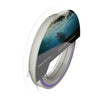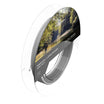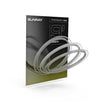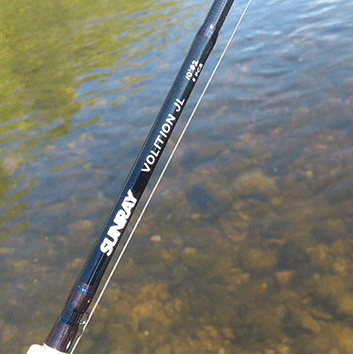It never ceases to amaze me how reticent most flyfishers are to embrace change, or in some cases even think logically about their approach to their fishing tactics. Even now, over seven years since Tenkara was introduced into the UK there are those who claim that it is not flyfishing despite the fact that it is virtually identical to how the likes of Izaak Walton & Charles Cotton fished in the late 1600s, long before modern rods, reels & running lines had been invented. Furthermore these funnel-visioned folks seem to be totally unaware of how effective Tenkara can be when applied to complex pocket-water situations.
Another technique that many closed-minded flyfishers consider to be ‘not proper flyfishing’ is Euro/French/Spanish/Polish/Czech nymphing, yet in its various forms it can be just as skilled as casting a dry fly to a rising fish. In fact casting a French leader setup at anything other than close range can be far more demanding of the angler’s skill than casting a conventional 3, 4, 5 or 6 weight line plus tapered leader. I have always strived to get the best presentation possible for my fly/flies & even in the 1960s, when I started flyfishing, I used a 4 weight setup, considered at the time to be very light. Nowadays, even when fishing small still waters, I consider my 3 weight gear to be my heavy trout & grayling kit.
Many flyfishers think of Euronymphing tactics as being just applicable to river situations, which brings me to the point of this article, the use of modified Euronymphing tactics for small still water trout. My local small still water is a U shaped canal fed from the local chalk stream system. It is only stocked irregularly & the fish very soon wise up to standard still water tactics (pulled Blobs & Cats Whiskers or flies fished under a Bung etc.). Once they have been educated they turn onto the abundant natural foods, tiny Chironomid midges in their three main stages, larvae/bloodworms, pupae & adults. These are best imitated on hooks of size 20 & smaller.
Presentation is the main problem when fishing imitations of these micro-flies. If fishing ‘on the drop’ the flies must sink vertically (not swing in an arc, tethered by a tensioned tippet): to achieve this dump casts are essential to provide enough slack in the tippet. If fishing a suspended fly at a fixed depth it must ‘dead-drift’ at the pace of the subsurface flow, with not the slightest cross-current drag. Here again a suitable amount of slack is required in tippet & leader, plus when required reach casts & line mends. To further complicate things, often the surface flow is different from the subsurface flow because of the influences of surface wind & subsurface friction with the lakebed & weed beds: as a result I regularly check the surface & subsurface flow rates by throwing in two small balls of paper tissue, one wetted so it sinks & the other dry so that it floats: I can then check that they drift at the same pace: if there is a big discrepancy in their drift rates I know that I can not present my fly properly so I move to another area of the lake. I should add that even in enclosed lakes with no inlet or outlet streams the water is never still as wind creates surface drift & often the subsurface water flows in the opposite direction.
My favoured setup for fishing micro-flies on small still waters is a modified Euro Nymphing rig using the Zero rod, #0 weight Sunray Jeremy Lucas Dr Fly, 7' of 4x tapered leader to which I attach loop to loop an 18” semi curly bicoloured indicator using mini-perfection loops (used for subsurface flies only) & to this I attach a suitable length of tippet (usually 0.12 to 0.09mm diameter copolymer, depending on the size of fly & the size of fish expected). The big advantages of this setup over a typical 5, 6 or 7 weight rod & line with flies suspended under a ‘bung’ are as follows:
- Casting causes minimal disturbance so spooks far less fish, yet a competent caster can cast a surprising distance with this light gear, plenty far enough to fish effectively on most small still waters. Furthermore frequent recasting is necessary, even with slack-line casts, plus frequent mending of the line, since generally only short drifts can be achieved before drag sets in.
- The well greased semi curly or curly indicator is quite adequate to support light flies (buzzers, bloodworms & nymphs) & is super-sensitive, indicating the slightest twitch. Furthermore, since a taking fish feels virtually no resistance, takes are far more positive with far fewer abortive twitches due to the fish rejecting the fly when they feel the resistance of a bung or the drag from a heavy fly line.
- It is far easier to mend a light, well greased line.
- Less force is needed to move the line & indicator when striking which reduces the risk of breaking fine tippet
- A light line, soft actioned rod is far better for protecting light tippets when hooking & playing good sized fish
- This light gear is much more pleasant to fish with & gives good sport with smaller fish, whilst still having the capacity to land bigger fish.
When using this setup it is important to ensure that the fly or flies are light enough to be supported by the greased indicator. Watch the tip of the indicator for any slight movement, although usually there will be a clear straightening of the coils. Whilst the fly is sinking, if the surface is calm enough, keep an eagle eye on the point where the tippet is being pulled under the surface & strike at any change in sink-rate as a lot of takes come as the fly is sinking, ‘on the drop’.
People have started using these tactics on other small still waters & have had considerable success, so much so that other anglers have approached them to see what ‘magic’ they were weaving to account for the number of takes they were getting. So, if you find that you are faced with very fussy fish, particularly if they are preoccupied with tiny buzzers or bloodworms, give this sensitive setup a try.

Size 24 Micro-buzzer Pupa tied with a 1.5mm tungsten bead & 3 colours of fine wire coated with UV resin

Rainbow & size 24 Micro-buzzer Pupa tied with stripped quill & thread coated with UV resin
































